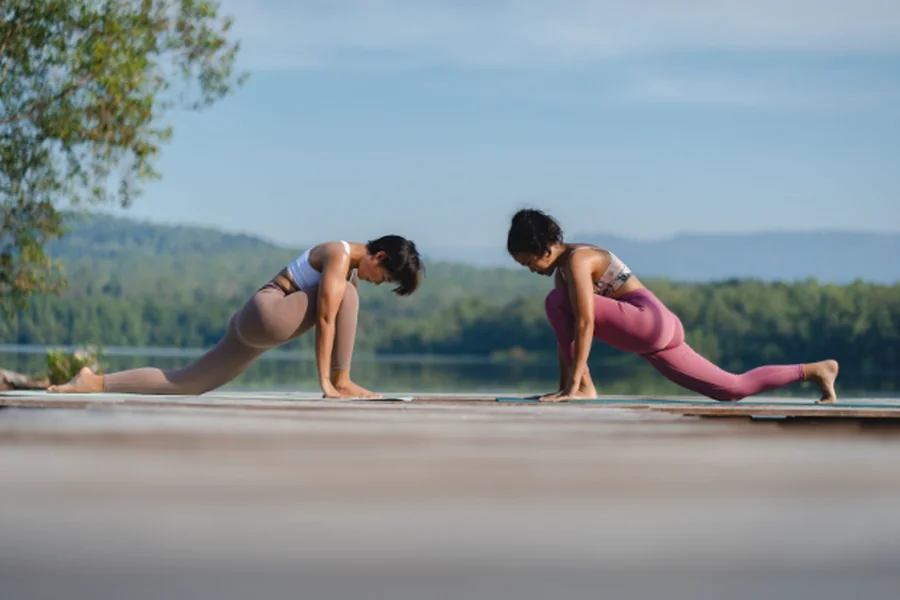Living with separation anxiety can feel overwhelming at times. That constant worry, fear, and distress when separated from loved ones or familiar places can severely impact your quality of life.
According to recent research, up to 98% of people with one mental disorder have at least one other mental health condition simultaneously.
This staggering statistic highlights why comprehensive approaches to treatment are so important. Yoga offers a complementary practice that can work alongside traditional separation anxiety disorder treatments, providing tools to manage symptoms and promote overall well-being.
Understanding Separation Anxiety and How Yoga Can Help
Separation anxiety disorder involves excessive fear or anxiety about separating from attachment figures. These feelings can be debilitating, affecting daily functioning and relationships.
The Mind-Body Connection
Separation anxiety manifests both mentally and physically. Your body responds to anxiety with increased heart rate, shallow breathing, and muscle tension. Yoga addresses both the physical and psychological aspects of anxiety through mindful movement and breathwork.
How Yoga Complements Traditional Treatments
Traditional separation anxiety disorder treatments typically include therapy approaches like cognitive-behavioral therapy and sometimes medication. Yoga serves as an excellent complementary practice, reinforcing many therapeutic concepts while providing immediate stress-relief techniques.
Yoga’s emphasis on present-moment awareness aligns perfectly with many therapeutic approaches used in treating anxiety disorders. Let’s explore specific practices that can enhance your treatment journey.
Five Effective Yoga Practices for Separation Anxiety
These targeted yoga techniques can be particularly helpful for managing separation anxiety symptoms and enhancing the benefits of your primary treatment plan.
1. Mindfulness Yoga Practices
Mindfulness yoga combines gentle physical postures with focused awareness on the present moment. This practice helps interrupt the cycle of anxious thoughts about separation.
To practice: Start in a comfortable seated position. Notice sensations in your body without judgment. As you move through gentle poses, maintain awareness of your breath and physical sensations. When thoughts about separation arise, acknowledge them without attachment and return focus to your breath.
This approach helps reduce the grip of anxious thoughts and builds the skill of present-moment awareness, which is invaluable during moments of separation anxiety.
2. Breath-Centered Yoga for Anxiety Regulation
The breath serves as a powerful tool for reducing anxiety with separation anxiety treatment. Specific breathing techniques can activate your parasympathetic nervous system, triggering your body’s relaxation response.
Try alternate nostril breathing (Nadi Shodhana): Sit comfortably and use your right thumb to close your right nostril. Inhale through your left nostril, then close it with your ring finger. Release your thumb and exhale through your right nostril. Repeat for 5-10 cycles when feeling anxious about separation.
This practice calms your nervous system and promotes emotional balance, making separation situations more manageable.
3. Grounding Poses to Create Safety
Separation anxiety often involves feeling unmoored or unsafe when apart from attachment figures. Grounding yoga poses can create a sense of stability and security.
Practice Mountain Pose (Tadasana): Stand with feet hip-width apart, spreading your toes and pressing evenly through your feet. Engage your leg muscles, lengthen your spine, and relax your shoulders. Feel your connection to the earth beneath you. Breathe deeply for 1-2 minutes.
This pose promotes physical and emotional stability, teaching your body what safety feels like even when separated from loved ones.
4. Heart-Opening Poses for Emotional Release
Separation anxiety often manifests as tightness in the chest. Heart-opening poses can release this physical tension while addressing the emotional components of anxiety.
Try Supported Fish Pose: Place a yoga block or rolled blanket lengthwise under your upper back and lie back, allowing your arms to rest out to the sides. Feel your chest expand with each breath for 3-5 minutes.
These poses create space for emotional processing and release, complementing the emotional work done in therapy sessions.
5. Restorative Yoga for Reducing Stress
Chronic anxiety depletes your energy reserves. Restorative yoga practices help replenish these reserves and reduce the overall stress burden on your system.
Practice Legs Up the Wall: Sit sideways next to a wall, then swing your legs up as you lie back. Rest with your legs extended up the wall for 5-10 minutes, focusing on deep, slow breathing.
This gentle inversion calms your nervous system and provides deep relaxation, making it easier to implement other techniques from your separation anxiety treatment plan.
Integrating Yoga with Your Treatment Plan
Consistency is key when incorporating yoga into your separation anxiety treatment. Here’s how to make it work effectively alongside your other therapeutic approaches.
Starting Slowly
Begin with short, 10-minute practices focused on breathing and simple postures. Gradually increase duration as you become more comfortable with the practices.
Creating a Safe Space
Establish a dedicated space for your yoga practice that feels secure and comfortable. This physical safety can translate to emotional safety during separation scenarios.
Remember that yoga is meant to complement, not replace, professional separation anxiety disorder treatments. Always consult with your healthcare provider before starting any new wellness practice.
FAQs
What are the most effective techniques for managing separation anxiety?
Some ways to manage anxiety disorders include mindfulness, relaxation techniques, correct breathing techniques, dietary adjustments, exercise, building self-esteem, cognitive therapy, exposure therapy, structured problem solving, medication and support groups.
Which yoga practice is most beneficial for reducing separation anxiety?
Poses where you fold forward, like child’s pose, tend to be calming. They allow you to tune out the rest of the world and feel quiet and peaceful. Stay in a forward fold for 3 or 4 full, slowing breaths, and allow your body and mind to relax.
What are the best yoga poses specifically for anxiety?
Some of the best yoga poses for anxiety include Child’s Pose (Balasana), Legs Up the Wall (Viparita Karani), and Seated Forward Fold (Paschimottanasana). These poses activate the parasympathetic nervous system, encouraging your body to relax.
Finding Peace Through Practice
Yoga offers valuable tools that can enhance the effectiveness of separation anxiety disorder treatments. These five yoga practices—mindfulness yoga, breath-centered techniques, grounding poses, heart-openers, and restorative yoga—address different aspects of separation anxiety, from physical tension to emotional distress.
By incorporating these practices into your routine, you’re giving yourself additional resources to manage anxious moments when they arise. Remember that healing takes time, and self-compassion is an essential part of your journey toward managing separation anxiety more effectively.






